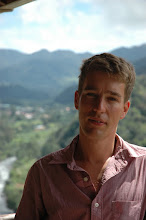I was reading an article in the Hindustan Times earlier today comparing public lavatories in Delhi and London. Apart from thinking that the article was a bit over generous in asserting how pleasurable it is to visit a typical British WC, it put me in mind that I haven't yet mentioned toilets in this blog. This is undoubtedly an oversight which I need to rectify. Relieving oneself in the best available comfort is an issue that overlanders think about on a daily basis. It is as much a part of the travelling experience as the sights, the scenery and the ongoing war of attrition with mosquitos. After four months on the road I'm becoming quite a connoisseur of the Asian lavatory experience.
The first thing you need to master on the road is a stable stance for the squat toilet. You really don't want to go tumbling backwards into the hole in the floor, nor do you want to dump your doings into the pulled down seat of your pants. Once you've got this mastered, squatting can actually become quite enjoyable, particularly when you're out in the fresh air on bush camps. Tonka and Archie are amply supplied with 'shit shovels' to aid this process and ensure we're not littering the landscape. The idea is to dig yourself a hole in which to aim and then to fill it in afterwards with the piled up earth. A surprising number of people seem to experience early problems with their aim, but as with most things in life, practice makes perfect, and you get a lot of practice on a trip like this one. The 'dig your own hole' policy isn't one followed by many Indians, who merrily leave their turds to bake in the midday sun, whetting the appetite of the local pork life in the process. I've even heard that these pigs are actually owned by the Government and have been introduced expressly for the purpose of providing an organic solution to the human excrement problem. Certainly you tred warily in long grass in India.
I had imagined at the outset that India would offer the very worst in Asian toilet experiences. However, this was unfair. When you do find public loos, and they're not widespread, they really aren't all that bad in my experience. You need to bring your own paper of course, but surprisingly often you are welcomed by a proper western sit down loo. In fact the prize for worst toilets encountered in Asia goes unquestionably to China, though a renegade group of fellow travellers did put in a good word for an especially nasty pit toilet at the Turkmenbashi dockyard in Turkmenistan.
China has quite a social approach to the whole crapping thing. Though public lavatories are widespread compared to in India, they are universally holes in the ground other than in more expensive hotels. Furthermore, the sense of community living in China is sufficiently strong to discourage the building of actual cubicles in many places. Instead, you squat merrily alongside your fellow man enjoying a good old chinwag between strains, separated solely by a very low wall. No danger of accidentally opening the door on anyone else either, since there ain't no doors to open.
One thing you do learn is that full-on toilet horror is more a matter of smell than of sight. This was demonstrated at Everest Base Camp in Tibet where my journey to the drop zone literally involved picking my way through a minefield of desiccating human turds that stretched wall to wall all the way to the entrance, - and I mean the entrance to the building not the cubicle! However, altitude was my friend that day, so there was little in the way of aroma to accompany the visual devastation. Unfortunately, the same was not true of my all-time worst loo encounter which took place at a grotty little restaurant stop on the Karakorum Highway in western China. Battle hardened as I am, this was the one time in the trip where I actually gagged at twenty paces from the target, eventually having to abort my mission altogether, or at least divert it to the friendly cover of a hillside bush. Unfortunately I did get close enough to see a mountainous pile of steaming turds poking right up through the squat hole before I finally fled in terror. It was a sight I hope never to see again in my travels and the awful stench haunted me for days afterwards.

